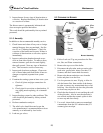
Modu-Fire
®
Gas-Fired Boiler Maintenance
28
14. When the load is below the low fire rating of the
boiler the boiler will continue firing and the out-
let water temperature will rise until it reaches
the set point + hysterises value. At this point
the operating control switch opens and the com-
bustion control is de-energized at Terminal 6
and the indicator for HEAT is turned off. This
action also de-energizes Terminal 9 thus closing
the main gas valve and the air gas ratio control
valve. Relay-1 and 2 are de-energized which
applies power to the close terminal of the air
damper motor. The air damper closes.
15. When the water temperature is reduced by the
load on the system, the operating control switch
will close again. The operating sequence will
recycle to step 5, provided the limits on water
flow, gas pressure and high temperature are all
met.
5.5.2 IRI Modulating
1. When the On/Off (Main power) switch is turned
on, the switch illuminates. Power is provided to
the flame safeguard control, the temperature
control, and through the flame safeguard control
to the damper close terminal. Power is also ap-
plied through the proof of closure switch on the
air gas ratio control, and to the “start logic
string” a series of normally closed switches, in-
cluding water flow, gas pressure, high stack
temp, high limit temperature, and operating
temperature to the flame safeguard programmer.
2. The water flow limit switch is closed when
there is water flow through the boiler.
3. Note: The closing of this switch does not prove
that flow is adequate. Refer to Technical Data
Sheet # TD110 for proper flow requirements.
4. When gas pressure is available, the low gas
pressure limit switch is closed. Manual reset is
required following conditions resulting in low
gas pressure.
5. When the temperature sensed by the high limit
temperature control is below the set limit, the
switch is closed. Manual reset is required fol-
lowing conditions exceeding high limit tempera-
ture.
6. When heat is required as indicated by the outlet
water temperature, power is applied to Terminal
6 of the programmer, which initiates the burner
ignition and operation sequence.
7. The flame safeguard control first energizes
Terminal 5 which energizes control relay R1,
energizes the motor contactor for the blower
motor, and supplies power to the air flow
switch, which initially shows low air flow with
the “Low Air “ indicator. This indicator will
remain on until air flow is sensed. Terminal 12
is also energized which drives the air damper to
the open position. When the damper motor is at
the full open position, the high fire limit switch
is made which energizes the high fire switch in-
put terminal 19 on the flame safeguard control.
8. Once sufficient airflow is indicated by the air
flow switch, Terminal 7 of the flame safeguard
control is energized. If the high fire switch and
proof of closure switch are in the correct state,
this starts the Prepurge period. The combustion
chamber is Prepurged for 30 seconds.
9. When the Prepurge time period elapses the
flame safeguard control energizes terminal 14,
which drives the damper motor through the po-
sition switch to the start position.
10. When the damper motor is at the start position,
the start position limit switch is made, which
energizes the low fire switch input terminal 18
on the flame safeguard control. A 10-second
“trial for ignition” period is initiated with both
Terminal 8 and 10 being energized. Terminal 10
of the combustion control powers the ignition
transformer. The transformer output creates a
spark at the igniter. Terminal 8 powers the pilot
gas valve.
11. When a pilot flame is detected by the UV scan-
ner a signal is sent to the combustion control.
When this signal is detected, Terminal 10 of the
combustion control is de-energized terminating
the spark.
12. After the 10 second “Pilot Flame Establishing”
period, if pilot flame has been established, Ter-


















